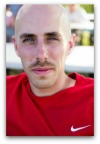of the Chosun Taekwondo Academy e-newsletter
Buyeo, The Gateway to Baekje
Just a few hours south of Seoul, is a sleepy little town that was once home to one of Korea’s greatest kingdoms. That town is Buyeo, formally Sabi, which was the Baekje capital from 538 AD until the dynasty’s collapse in 660 AD at the hands of the Shilla (Gyeongju) and Tang (China). While most tourists to Korea visit Gyeongju, few have heard of the wonders of Baekje that Buyeo has to offer.
 |
| Jeongnim Temple Buddha Statue |
At the heart of the city is Busosanseong, a mountain fortress with earthen walls, pavilions, and temples. The back side of the mountain is highlighted by Nakhwaam cliff (falling flowers rock) which overlooks the Baengma River. Legend has it that upon the kingdom’s fall at the hands of Shilla and Tang, 3000 court ladies of Baekje refused to surrender and leapt from this cliff. It is said that the sight of their colorful dresses fluttering in the air looked like flower petals floating down into the river, hence the cliff’s name. From the base of the mountain, you can take a ferry down the river providing you with an excellent view of the cliff.
Other sites that shouldn’t be missed include Gungnamji Pond, Jeongnim Temple, the Baekje Royal Tombs, and Baekje Culture Land. Gungnamji is Korea’s first artificial pond and is surrounded by willow trees, covered in lotus blossoms, and highlighted by a pavilion atop a small island in the middle of the pond. Jeongnim Temple sits in the center of the city and has its own museum as well as one of only two remaining Baekje stone pagodas and a Goryeo era stone Buddha statue. Baekje Culture Land is also worth visiting. Although a recreation, it’s a magnificent example of how the ancient capital once looked. While Sabi Palace is certainly impressive, it is the 5 story wooden pagoda of the reconstructed Neung Temple that attracts the most attention. Together, all of these sites make Buyeo one of Korea’s best kept secrets.
Read the entire newsletter
Subscribe on the Chosun Taekwondo Academy homepage: www.chosuntkd.
About the author:
Jeff W. Rosser is a teacher, martial arts instructor, and writer in South Korea. He’s a former AAU U.S.A. National Karate Team member and has competed internationally in Karate and Taekwondo. He also has over 22 years of experience in Karate, Taekwondo, Ju-Jutsu, and Judo. He’s a columnist for Taekwondo Times (“The Hidden Art”),writes monthly for
TotallyTaekwondo Magazine and is the author of Combative Elbow Strikes: A Guide to Strikes, Blocks, Locks, and Take Downs, an in-depth analysis of the practical applications for five of the most common elbow strikes found in the martial arts.
Contact info: karatekajwr@yahoo.com (Email)
About the author:
Jeff W. Rosser is a teacher, martial arts instructor, and writer in South Korea. He’s a former AAU U.S.A. National Karate Team member and has competed internationally in Karate and Taekwondo. He also has over 22 years of experience in Karate, Taekwondo, Ju-Jutsu, and Judo. He’s a columnist for Taekwondo Times (“The Hidden Art”),writes monthly for
TotallyTaekwondo Magazine and is the author of Combative Elbow Strikes: A Guide to Strikes, Blocks, Locks, and Take Downs, an in-depth analysis of the practical applications for five of the most common elbow strikes found in the martial arts.
Contact info: karatekajwr@yahoo.com (Email)

No comments:
Post a Comment